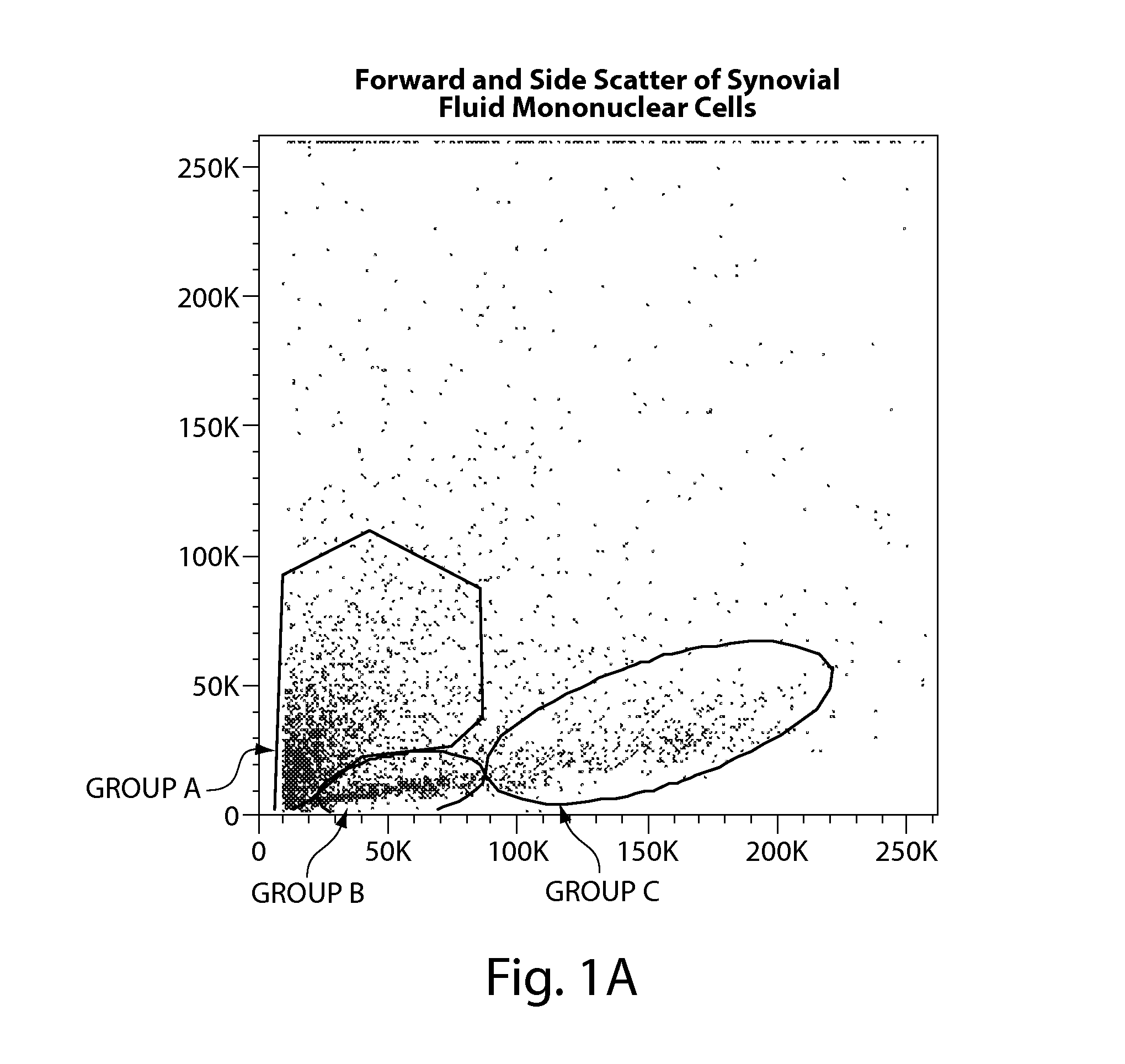Multipotent stem cells and uses thereof
a multi-potent stem cell, stem cell technology, applied in the direction of skeletal/connective tissue cells, drug compositions, immunological disorders, etc., can solve the problems of critical shortage of stem cells, difficult to obtain sufficient human stem cells, and difficult to achieve embryonic-like effects
- Summary
- Abstract
- Description
- Claims
- Application Information
AI Technical Summary
Benefits of technology
Problems solved by technology
Method used
Image
Examples
example 1
Purifying and Enriching Stem Cells from Synovial Fluid
[0194]In a first step, freshly isolated synovial fluid was obtained from an osteoarthritic (OA) patient. Synovial fluid mononuclear cells were thus derived from joint aspirates. Joint aspirates can be obtained by standard methods well known to those of skill in the art.
[0195]Harvesting SF Stem Cells (Heterogenous Population).
[0196]Synovial fluid (SF) from OA patients was harvested, diluted in serum-free medium (AIM-V, GIBCO) or MCDB, MEM, IMDM, RPMI media, and spun at 200 g for 15 minutes at room temperature (RT). The pelleted population was then resuspended in AIM-V up to the original SF volume. The mononuclear cell number from SF ranged between 500,000 to 5 million heterologous mononuclear cells.
[0197]Harvesting SF Stem Cells (Homogenous Population)
[0198]The pelleted population was then resuspended in AIM-V, serum free medium developed for the ex vivo expansion of human lymphocytes, up to the original SF volume, counted, washed...
example 2
Characterization and Expansion of Enriched Stem Cells
[0202]Both populations of separated cells (i.e., from the buffy layer or the pellet) were incubated with anti-MHC class I, anti-CD66b, and anti-glycophorin b, immunomagnetic beads as described above. Samples were first assessed for the expression of MHC class I, MHC class II, CD44, CD45, CD13, CD34, CD49c, CD66b, CD73, CD105 and CD90 cell surface markers and then permeabilized to determine the presence of Oct-4, Nanog, Sox-2, Rex-1, GDF-3, and Stella intracellularly. FIGS. 1a-1e are dot plots of the enriched cells, sorted into 3 groups (e.g., Group -A, -B, and -C) and analyzed for Oct-4, Rex-1, Runx2, Sox-9, Nanog, Class I, CD44, and CD45 expression. Six to thirty percent of total mononuclear population, i.e., groups A and B, expressed Oct-4, Nanog, Sox-9, and Rex-1 while group C expressed the aforementioned transcription factors at high levels, with the exception of Oct-4. The majority of the cells were negative for the above cel...
example 3
Propagation of Synovial Fluid Stem Cells
[0203]Heterogenous or homogenous populations of SF stem cells not incubated with immunomagnetic beads were plated onto culture dishes coated with about 7-10 ng / ml serum fibronectin or other appropriate matrix coating. Cells were maintained in Dulbecco Minimal Essential Medium (DMEM) or 40-60% (e.g., 60%) Low Glucose DMEM and 40-60% (e.g., 40%) MCDB-201 medium supplemented with 1-50 ng / ml (e.g., about 5-15 ng / ml or 10 ng / ml) platelet-derived growth factor-BB (PDGF-BB), 1-50 ng / ml (e.g., about 5-15 ng / ml or 10 ng / ml) epidermal growth factor (EGF), 1-50 ng / ml (e.g., about 5-15 ng / ml or 10 ng / ml) insulin-like growth factor (IGF), or 100-10,000 IU (e.g., about 1,000) LIF, with 10−11 to 10−8 M (e.g., 0.01 nM) dexamethasone or other appropriate steroid(s), 2-10 μg / ml (e.g., 4.7 ng / ml) linoleic acid, and 0.05-0.15 μm (e.g., 0.1 μm) ascorbic acid. The culture medium may further include 10-50 ng / ml (e.g., 10 ng / ml) insulin, 0-10 ng / ml (e.g., 5.5 ng / ml) ...
PUM
| Property | Measurement | Unit |
|---|---|---|
| size | aaaaa | aaaaa |
| size | aaaaa | aaaaa |
| size | aaaaa | aaaaa |
Abstract
Description
Claims
Application Information
 Login to View More
Login to View More - R&D
- Intellectual Property
- Life Sciences
- Materials
- Tech Scout
- Unparalleled Data Quality
- Higher Quality Content
- 60% Fewer Hallucinations
Browse by: Latest US Patents, China's latest patents, Technical Efficacy Thesaurus, Application Domain, Technology Topic, Popular Technical Reports.
© 2025 PatSnap. All rights reserved.Legal|Privacy policy|Modern Slavery Act Transparency Statement|Sitemap|About US| Contact US: help@patsnap.com



